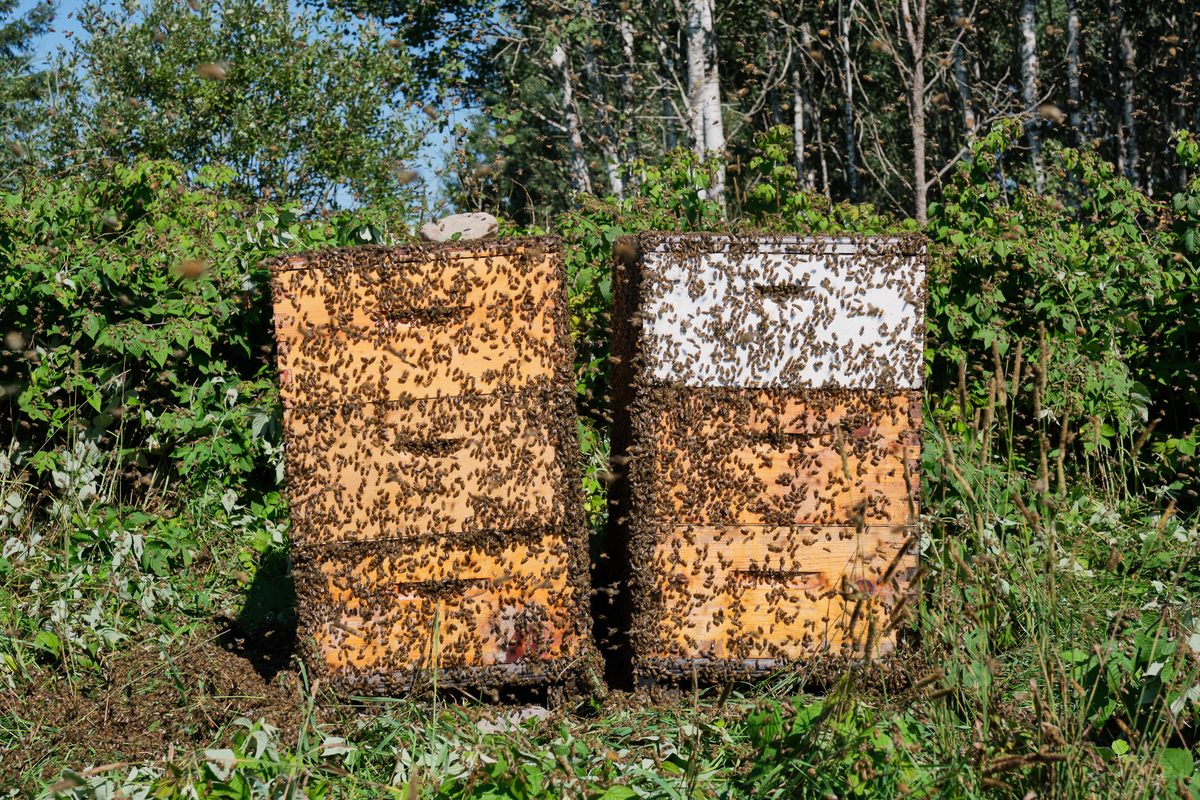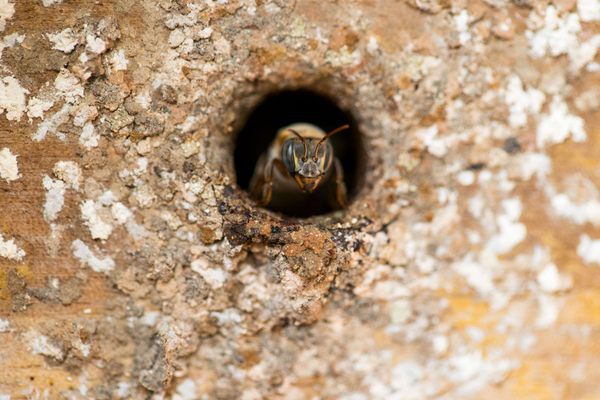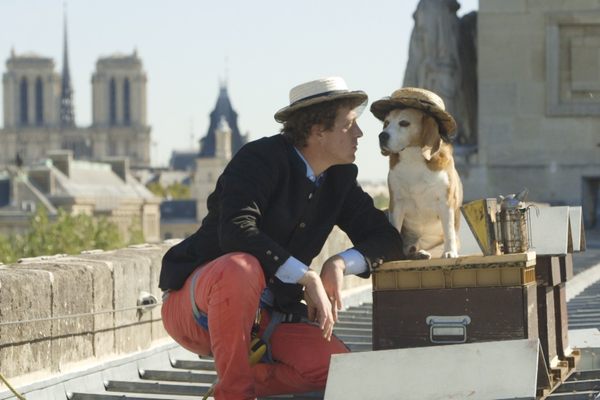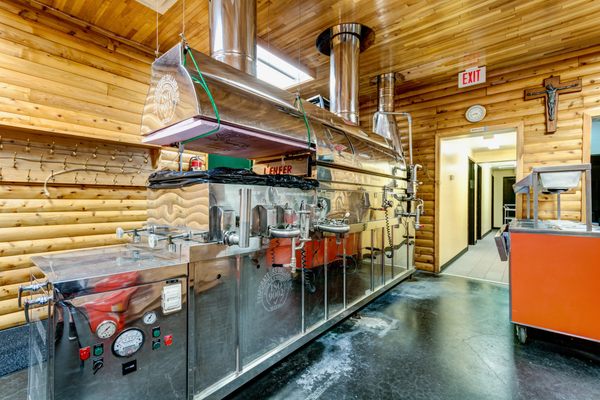Anicet Desrochers slips the small, crowbar-like tool underneath the lid of the beehive and cracks the propolis seal, a glue that bees make from resin. He puffs a smoker over the box as he pulls and examines the honeycomb frames with bare hands. The smoke, he says, disrupts the bees’ alarm pheromones, making them groggy, while also causing them to gorge on honey and nectar, a possible response to believing there is a fire. When they’re full, they’re less likely to sting.
His team of half a dozen beekeepers tackle the rest of the bee yard, pulling down the honey-heavy boxes, each six-foot stack containing 200 pounds of honey. As the harvest progresses, the bees fill the air with their electric buzz and speckle the sky black. There’s the occasional curse of “tabernac” each time a beekeeper is stung. Desrochers insists on no gloves—they have to remain sensitive to the bees. Sometimes he even does tai chi with his team to set the right energy. He approaches his work with bees more as a collaboration than subjugation.

As the team finishes loading the trucks with several thousand pounds of honey, Desrochers takes a moment to admire the chaos of hundreds of thousands of bees droning around him. “You cannot do beekeeping if it’s only for money,” says the 42-year-old beekeeper. “It’s so demanding, you need to really be in love with the bee.”
While Desrochers’s parents kept bees, they used the honey to produce mead. When he took over and launched his business, Miels d’Anicet, in 2000, he wanted to focus on the honey’s quality. But first he had to reckon with the bees he’d inherited. At that time, all Quebec’s beekeepers used yellow Italian bees, which don’t do well in his home of Ferme-Neuve in the High Laurentian mountains. In order to have a bee that could thrive in the short summers and cold winters, he studied the art and science of queen-bee breeding, which he describes as the most complex realm of beekeeping.
For us, bees are both workers—they pollinate a third of our food—and livestock: They produce about 1.9 million tons of honey globally each year. So there’s a lot at stake in what kinds of bees we use. But they’re more challenging to breed than a cow or pig. Bees are short-lived, they’re never truly domesticated, and you can’t just put two in a box and hope they mate. “The bees are still wild because if they don’t want to do what you want them to do, they take off,” says Desrochers. Yet over the past two decades, he has succeeded in refining his breeding technique and his personal bee strain, becoming the largest queen-bee producer in Canada and one of the leading practitioners of this wondrously specific skill.
Desrochers hadn’t planned to become a beekeeper like his parents. He wanted to escape his remote town to study anthropology and to travel. But soon after graduation he was in Réunion, studying their medicinal plants, and met a family of beekeepers. There he realized this ancient practice of beekeeping could connect him to others across the world, not just keep him trapped in Ferme-Neuve, and that bees knitted together his disparate passions. “Beekeeping touches everything,” he says, “botany, biology, ethnology, anthropology, gastronomy.”

After learning from breeders in British Columbia and California, he went in search of bees from around the world that had characteristics suited to his environment. The majority of honey bees belong to the apis mellifera species, believed to have originated in Africa, which spread across the world and evolved into unique sub-species due to regional environments. From Russia, Desrochers acquired the Primorsky bee, known for their cold hardiness and resistance to mites. He went to Slovenia for the Carniolan bee, which is good at foraging on cold days and surviving long winters—his wife, Anne-Virginie Schmidt, actually smuggled them home. “They were in my bag,” she says, “but when I went to customs I knew I would wear a dress and put the cages underneath.” They began to buzz against her because of her warmth. He brought apis mellifera monticola back from Kenya, a gentle bee that lives above 6,500 feet on the slopes of Mount Kenya and Kilimanjaro. Then he added Caucasian bees from the Caspian region that a friend in Vancouver gave him.
While there is evidence of beekeeping dating back to ancient Egypt, breeding began with the bee’s modern domestication, probably around the mid 1800s with the creation of the Langstroth hive. The Reverend Lorenzo Langstroth built an easy-to-use hive of removable frames on the basis of “bee space,” a roughly one-centimeter gap that allows bees to move freely. Any less and the bees fill the space with propolis; any more and they construct honeycomb.
To breed his bees, Desrochers narrows down the top 100 colonies each spring from his 1,200 hives, then chooses the top 10 to use, and sends some to a university breeding program. The characteristics that make a bee suitable to his climate also help his clients across the continent who buy his queens. “My main focus, and it’s still the same right now, is to find a bee that will resist and tolerate pressures like climate change, diseases, parasites, and of course being productive.” Though he can accomplish a lot through observation and intuition, he lacks the time and resources to select based on detailed scientific data.
For this, he has collaborated for nearly 20 years with Pierre Giovenazzo, a professor at the University of Laval who employs genetics, statistics, Big Data, and artificial intelligence in his bee-breeding program. “We have developed a statistical model,” says Giovenazzo, “so we don’t just select based on observations, we select based on measurements.” His lab’s focus on both genetic and environmental factors makes it a scientific leader within North America and internationally.

Using techniques developed in the pork and dairy industries, he and his team document each bee’s lineage in what is called the “studbook,” which gives each bee a “breeding value” based on the history of the line’s performance over the past decade. He measures criteria that are important to beekeepers in northern climates such as how well they survive the winter; how quickly the colony can grow in the spring, an important quality in such a short season; disease resistance; aggressiveness; and honey production.
Giovenazzo populated the breeding program with a variety of local and imported bees, including some of Desrochers’s hybrid bees. When Giovenazzo selects the best bees, he sends them back to the beekeepers who multiply them, observe them, and send back the best ones in a cyclical exchange that progressively leads to a better bee. There are similar programs throughout the world, each working towards a bee suited to the local climate and needs. In Europe, there is a strong focus on preserving the local lines of indigenous bees, which have been shown to outperform imported bees.
One of the challenges of bee breeding is being able to see what is happening inside the dark hive. So this year Giovenazzo is installing Nectar sensors in Desrochers’s hives, a novel technology being rolled out across the world, which constantly measures temperature, humidity, vibration, and movement, beaming back the information in real time to then be processed by algorithms. “What the sensors will give me as a researcher is the information we need to do precise performance evaluations in situ at the beekeeper site,” he says. He also has plans next year to follow the queens down the chain to some of Desrochers’s buyers so he can study how the genetics evolve through subsequent generations.
Tracking and breeding cows through successive generations is relatively easy. For bees, not so much. Moving down generations from the originally bred queen, it’s easy to quickly lose these selected genetics. A queen mates in one flight with 15 to 20 drones and stores that sperm for her entire life to lay eggs. So the first generation that she lays will carry the desired characteristics, but when the next queen mates, it will be with random drones, which dilutes the genetics.

While Desrochers’s partnership with Giovenazzo exemplifies the challenges of breeding bees, he is unique in his focus on quality over quantity, which addresses this challenge. By constantly selecting both his queens and drones, and keeping the mating yard separate from the general population, he can slowly nudge his bees to be more resilient and adaptable. What allows him to do this is his isolation in northern Quebec: There is no other beekeeper for 150 miles, meaning his bees don’t mix with others and aren’t exposed to pesticides, which impacts the drone’s fertility and leads to fewer viable sperm in the queen. “What Anicet does is exceptional in Canada. He is a visionary and keen queen breeder,” says Giovenazzo. “I would put it like this: Of all bee breeders in Canada, there is Anicet and there are the others.”
The queen-breeding hives, small styrofoam boxes painted in various colors so the queens can recognize their home, wind a trail through a field of goldenrod. Each spring Desrochers and his team shake 800 pounds of bees from the regular colonies to populate these hives. Taking frames of honeycomb from his best breeder hives, he harvests 2,000 larvae one by one using a precise scapular tool, placing them in a thimble-sized container with a dab of sugar paste. These are inserted into the queen-less hives. When a colony is without a queen, they go about making a new one out of this serendipitous larva.
Any larva can become a worker, drone, or queen depending on what food the colony feeds it. A queen receives only royal jelly, a protein-rich secretion that nurse bees feed to a queen 10,000 times during development. Once the queen emerges and mates, then the beekeepers spend a day opening each hive, pinching her gently between their fingers—on average she’ll be there 75 percent of the time—and packaging her in a small cage with three worker bees and some sugar paste for the journey. This is then shipped to beekeepers across Canada and the United States. Desrochers produces 15,000 queens each season, the largest producer in Canada, but he is small compared to breeders in California and Hawaii, some of which can ship a thousand queens per day to meet the need of pollinating, for example, the massive almond orchards of California.

Jean-Marc Le Dorze, Desrochers’s largest buyer, runs Golden Ears Apiaries in Mission, British Columbia. He uses his 5,500 hives to pollinate blueberry and canola fields. Transporting his bees to Alberta on tractor trailers over the Rocky Mountains, as well as the demands of industrially scaled pollination, are tough on the bees, but Le Dorze says Desrochers’s bees are pretty hardy. The quality of Desrochers’s bees leads to efficiencies in his business: Whereas queens from California would fly off the truck, these ones stay, remaining calm and less aggressive; those imported from the South don’t even live for a year, while Desrochers’s bees last two years under these rough conditions. They also require half the amount of sugar syrup that Le Dorze uses to overwinter them when they hibernate.
Breeders such Desrochers can help the wider industry become more productive with bees that are better adapted to a changing climate and diseases. But he can’t breed bees that will produce tastier honey. At least not directly. Instead, these hardy, well-bred bees can give beekeepers the chance to make more interesting, higher-quality honeys based on the location of the hives and how one manages the harvest.
In Desrochers’s case, the honey that he collects in his far-north location—something he can do thanks to his breeding program—is renowned for its diversity and complexity of flavors due, he says, to it being “wild,” not “agricultural.” While a lot of honey is produced by pollinating large fields of monocultures, he doesn’t put his bees into such environments; they’re left to do as they will throughout the river valley and surrounding forest and small pastures. Pollen analysis of their honey shows that 90 to 95 percent of what they collect is wild. “They can find 50 different kinds of pollen,” says Schmidt, “and they always say we have some pollen that can’t be found anymore in Quebec, like the old typical native flowers that have disappeared because the agriculture was too invasive.”

Healthy, productive bees that overwinter well and get strong quickly in the spring can take advantage of the different bloom cycles of the entire season. Desrochers then separates the honey by these cycles, and sometimes specific flowers and place, to highlight the terroir of time and location. In spring, if he’s lucky, the bees will forage from wild cherry and maple trees, as well as dandelions. Summer is a mix of linden, white clover, raspberry; fall has goldenrod and buckwheat. He harvests linden and buckwheat honeys individually when there are crops.
Each year he also tries to make a vintage honey, selecting and bottling a single bee yard, like a winemaker. Last year’s vintage was a result of both breeding and colony management working together to make a unique honey. It was cold until the end of May, so all the blooms were late, especially the maple and willow trees. A bee yard of 40 hives, located close to these trees, survived the winter with good enough numbers to sufficiently harvest from these two unusual food sources for a small bottling of “funky honey.”
“A special location, good bees at that point and then magic,” he says. “This year we don’t have it because it bloomed earlier. But this is why it’s so special. You never do the same thing. I’ve been working with bees for 20 years, I have some mentors that have been working bees 50, 60 years, old guys, every year we discover new things.”
Gastro Obscura covers the world’s most wondrous food and drink.
Sign up for our regular newsletter.

































Follow us on Twitter to get the latest on the world's hidden wonders.
Like us on Facebook to get the latest on the world's hidden wonders.
Follow us on Twitter Like us on Facebook